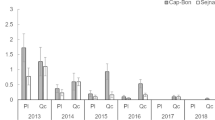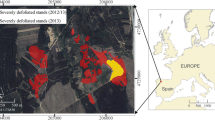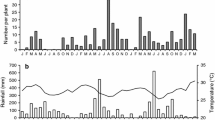Abstract
The Siberian moth, Dendrolimus sibiricus, Tschtv. is the most harmful defoliator of coniferous forests in North Asia. The pest has already spread over the Urals and continues moving westwards. Recently, it has been recommended for quarantine in member countries by European and Mediterranean Plant Protection Organization (EPPO). The performances of the pest on coniferous species planted in Europe were assessed on a range of potted trees corresponding to the spectrum of economically important conifers in the EU: European larch Larix decidua, Norway spruce Picea abies, Scots pine Pinus sylvestris, European black pine Pinus nigra, and the North American species: Douglas fir Pseudotsuga menziesii and grand fir Abies grandis. Larvae showed a potential to survive and complete the development on all these host tree species. Favorable hosts were grand fir, European larch, and Douglas fir that allowed higher survival, better larval development, and as a result, yielded heavier pupae and adult moths with higher longevity. Black pine was a poor host but, however, could still support larval and pupal development. Norway spruce and Scots pine had an intermediate behavior. If accidentally introduced to Europe, the Siberian moth may become especially damaging in forest stands predominated by European larch and by the North American firs. Norway spruce and especially the two-needle pines will be less prone to intensive defoliation by this species. The fact that the pest may damage the range of economically important coniferous species should be taken into account in the pest risk assessment for Europe and also for North America where the Siberian moth occurrence is considered likely.




Similar content being viewed by others
References
Baranchikov YN, Kirichenko NI (2002) Feeding and growth of caterpillars of the Siberian moth Dendrolimus superans sibiricus (Lepidoptera: Lasiocampidae) during summer diapause. Entomol Rev 82:1084–1089
Baranchikov YN, Kondakov YP (1997) Outbreaks of the Siberian moth Dendrolimus superans sibiricus Tschtvrk in central Siberia. In: Gottschalk KW, Fosbroke SLC (eds) Proceedings, Interagency Gypsy Moth Forum, USDA Forest Service, NEFES, GTR-NE-240, Newtown Square, PA, pp 10–13
Baranchikov YN, Perevoznikova VD (2004) Siberian moth outbreaks as an additional source of carbon flux. In: Chernov YuI (ed) VN Sukachev Memorial Meetings, vol 20, Insects in Forest Ecosystems, KMK Press, Moscow, pp 32–53 (in Russian)
Baranchikov YN, Kondakov YP, Petrenko ES (2001) Catastrophic outbreaks of Siberian moth in Krasnoyarsk Kray. In: Lepeshev AA (ed) National security of Russia. Znaniye, Krasnoyarskiy Kray, Moscow, pp 146–167 (in Russian)
Baranchikov YN, Petko VM, Ponomarev LV (2006) The Russians are coming – aren’t they? Siberian moth in European forests. In: Gottschalk KW, Fosbroke SLC (eds), Proceedings, Interagency Research forum on gypsy moth and other invasive species, 2006, USDA Forest Service, NFES, GTR-NRS-P-10, Newtown Square, PA, pp 18–20
Bogatyrev NR, Alekseev AA, Bogatyreva OA (2002) The study on behavior of larvae of the Siberian Moth Dendrolimus superans sibiricus Tschetvr. (Lepidoptera, Lasiocampidae). Siberian Ecol J Suppl 9:65–69 (in Russian)
Boldaruev VO (1969) Population dynamics of the Siberian moth and its parasitoids. Buryatskoye knizhnoye izdatelstvo, Ulan-Ude (in Russian)
Davis EE, French S, Venette RC (2005) Mini risk assessment. Siberian Silk Moth, Dendrolimus superans Butler. Lepidoptera: Lasiocampidae]. USDA Forest Service. http://www.aphis.usda.gov/plant_health/plantpest_info/pest_detection/downloads/pra/dsuperanspra.pdf. Accessed 20 September 2009
Epova VI (1999) The list of chewing-insects of Baikal’ Siberia. Nauka, Novosibirsk (in Russian)
EPPO (2005) Data sheets on quarantine pests: Dendrolimus sibiricus and Dendrolimus [sic] superans. European and Mediterranean Plant Protection Organization. [online] http://www.eppo.org/QUARANTINE/insects/Dendrolimussibiricus/DSDENDSI.pdf. Accessed 14 September 2009
EPPO (2006) Decision-support scheme for quarantine pests. European and Mediterranean Plant Protection Organization. Web version available at: http://archives.eppo.org/EPPOStandards/PM5_PRA/PRA_scheme_2006.doc. Accessed 4 June 2009
Essl F (2005) Verbreitung, Status und Habitatbindung der subspontanen Bestände der Douglasie (Pseudotsuga menziesii) in Österreich. Phyton 45:117–143 (in German, English abstract)
Florov DN (1938) The Siberian moth in East Siberia. OGIZ, Irkutsk (in Russian)
Geispitz KF (1965) Photoperiodical and temperature reactions effecting the seasonal development of pine moths Dendrolumus pini and D. sibiricus Tschtv (Lepidoptera, Lasiocampidae). Entomol Rev 44:538–553 (in Russian)
Gninenko Yu, Orlinskii AD (2002) Dendrolimus sibiricus in the coniferous forests of European Russia at the beginning of the twenty-first century. Bull OEPP/EPPO Bull 332:481–483
Kirichenko NI (2002) Experimental study of feeding and growth of the Siberian moth larvae. Ph. D. Thesis, V. N. Sukachev Institute of Forest SB RAS, Krasnoyarsk (in Russian)
Kirichenko NI, Baranchikov YN (2007) Appropriateness on needles of different conifer species for the feeding and growth of larvae from two populations of the Siberian moth. Rus J Ecol 38:216–221
Kirichenko NI, Baranchikov YN (2008) Feeding norms of the Siberian moth larvae reared on Siberian coniferous species. Sib Ecol J 15:709–715 (in Russian, English abstract)
Kirichenko NI, Flament J, Baranchikov YN, Grégoire J-C (2008) Native and exotic coniferous species in Europe–possible host plants for the potentially invasive Siberian moth, Dendrolimus sibiricus Tschtv (Lepidoptera, Lasiocampidae). Bull OEPP/EPPO Bull 38:259–263
Kirichenko NI, Baranchikov YN, Vidal S (2009) Host plant preference and performance of the potentially invasive Siberian moth (Dendrolimus superans sibiricus) on European coniferous species. Agric For Ent 11:247–254
Köble R, Seufert G (2001) Novel maps for forest tree species in Europe. Proceedings of 8th European Symposium on the Physico-Chemical Behaviour of Atmospheric Pollutants. Torino (IT). http://ccu.jrc.it/Pubblications/tree_species_maps.pdf. Accessed 15 November 2009
Liebhold AM, Gottschalk KW, Luzader ER, Mason DA, Bush R, Twardus DB (1997). Gypsy moth in the United States. An Atlas. USDA Forest Service General Technical Report NE-233.33
Mikkola K, Ståhls G (2008) Morphological and molecular taxonomy of Dendrolimus sibiricus Chetverikov stat. rev. and allied lappet moths (Lepidoptera: Lasiocampidae), with description of a new species. Entomol. Fennica 19:65–85
Orlinskii AD (2001) Quarantine pests for forestry. Bull OEPP/EPPO Bull 31:391–396
Rozhkov AS (1963) The Siberian moth. USSR ASc, Press, Moscow. (in Russian)
Sheskin DJ (2004) Handbook of parametric and nonparametric statistical procedures, 4th edn. Chapman and Hall, CRC Press, Boca Raton
Vinokurov NN, Isaev AP (2002) The Siberian moth in Yakutia. Sci Technol Yakutia 3:53–56 (in Russian)
Vshivkova TA (1976) Larix, fir and Siberian pine as host plans for the Siberian moth. In: Petrenko ES (ed) Ecological studies in forest animals, Krasnoyarsk, pp 150-161 (in Russian)
Yurchenko GI, Turova GI (2007) The Siberian and white-banded silkmoths in the Russian Far East. Monitoring handbook. Far Eastern Institute of Forest Management, Khabarovsk (in Russian)
Acknowledgments
We thank Alexey Pudovkin and Dmitriy Gorshnyakov (Shipunovskiy forestry, Altai, Russia), and Dr. Vladimir Petko (V. N. Sukachev Institute of Forest SB RAS, Krasnoyarsk Russia) for their assistance in collecting insects in the field and Jean-Marc Molenberg and Roberta Kolberg (Université Libre de Bruxelles, Belgium) for their valuable help at different stages of the indoor experiment. We very much appreciate the comments of two anonymous reviewers and the editor on a previous draft, which substantially improved the manuscript. The work was undertaken within the project PRAVEG financed by the Belgian Federal Service Public Health, Security of the Food Chain and Environment. The partial support was provided by the fund of President of the Russian Federation (grant No. MK-7049.2010.4), the Russian Foundation of Basic Research (grant No. 10-04-00196-a) and by the fund of the Siberian branch of Russian Academy of Sciences (Lavrentiev’s grant) (grant No. 19).
Author information
Authors and Affiliations
Corresponding author
Additional information
Communicated by J. Müller.
Rights and permissions
About this article
Cite this article
Kirichenko, N., Flament, J., Baranchikov, Y. et al. Larval performances and life cycle completion of the Siberian moth, Dendrolimus sibiricus (Lepidoptera: Lasiocampidae), on potential host plants in Europe: a laboratory study on potted trees. Eur J Forest Res 130, 1067–1074 (2011). https://doi.org/10.1007/s10342-011-0495-3
Received:
Revised:
Accepted:
Published:
Issue Date:
DOI: https://doi.org/10.1007/s10342-011-0495-3




